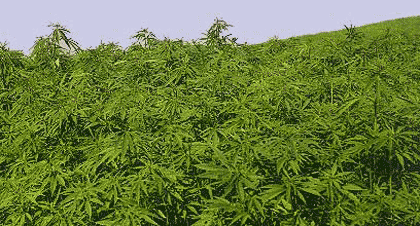The
Many Uses of Hemp
The Earth's Most Valuable,
Versatile and Sustainable Natural
Resource
Download this
information as a PDF File


Cannabis Sativa, L, the plant known in English as "Hemp" is a prolific farm crop that looks similar to kenaf, but it works in a much greater range of products and climactic conditions. different from marijuana. Although industrial varieties of hemp are related to marijuana, they are used differently and do not have the psychoactive effects. All parts of the plant are useful, and it is estimated that hemp can produce from 25,000 to 50,000 consumer products.
Seeds For Oil and Food
Hemp seeds produce high-grade vegetable oil for cooking, cosmetics, soaps, shampoos, lubrication, fuel, plastics, etc. The seed is a cholesterol-lowering source of full protein. It also posseses omegas, the essential fatty acids that are critical to human nureological and immunological well-being.
Stalk for Fabric, Fuel, Paper and Commercial Use
Hemp is dried and broken down into two parts: thread--like fibers and bits of "hurd," or pulp. Each has its own distinct applications:
The long bark fiber, or bast, at 77% cellulose, is cleaned and spun into thread, yarn or rope, or woven or knit into a variety of durable, high-quality textiles for clothing, canvas and fabrics of many textures.
The inner core that remains is called hemp hurds, an abosrbent material with cellulose for tree-free, dioxin-free paper; non-toxic paints and sealants; industrial fabrication materials; construction materials; hemi-cellulose for plastic, and much more! Hemp is the best sustainable source of plant pulp for biomass fuel to make charcoal, gas, methanol, gasoline or even produce electricity.
Rooted In Nature
Even the hemp roots play an important role: they anchor and aerate the soil to control erosion and mudslides. Hemp can save family farms, create jobs, reduce acid rain and chemical pollution, and reverse the Greenhouse effect. It does this naturally, because the hardy plant does not require chemical pesticides or herbicides, produces oxygen and consumes atmospheric carbon dioxide through photosynthesis, and uses cleaner manufacturing technology than forestry products, fossil fuels or petrochemicals.
Foliage for Medicine, Food and Relaxation
Cannabis has important medical value for easing pain, relieving stress and treating illnesses from glaucoma to cancer to nausea to AIDS and beyond. Hemp flowers and leaves are smoked or eaten for many therapeutic, religious and relaxational purposes. They contain 60 therapeutically active compounds, called cannabinoids, but only one makes people high (THC). The industrial hemp varieties do not contain significant amounts of THC, but they do contain other medicinal compounds like cannabidiol (CBD) and cannabinol (CBN). Varieties that produce more than 3% THC in the female flowers are called marijuana, which has been legalized as medicine in seven Sates.
Business Alliance for
Commerce in Hemp
For more information, read Hemp, Lifeline to the Future and Hemp for Health by Chris Conrad
BACK / NEXT

